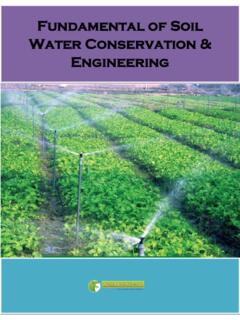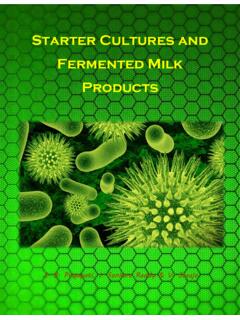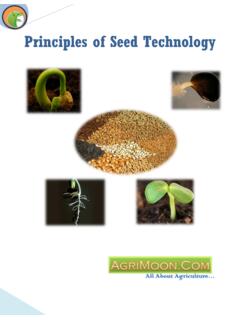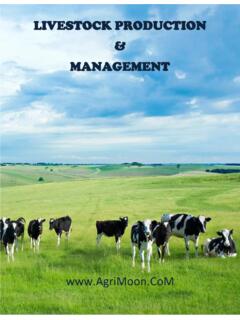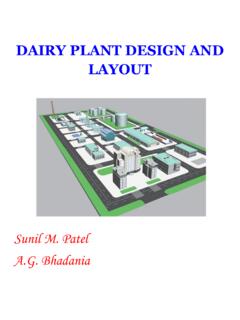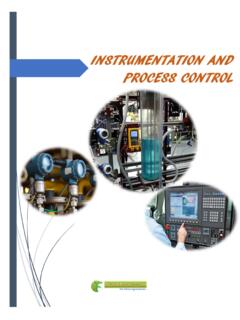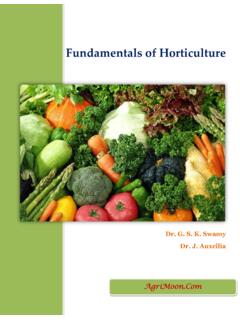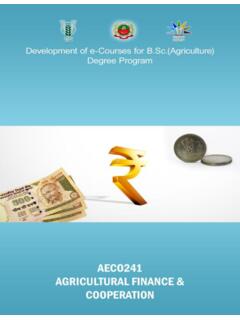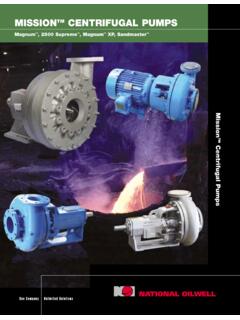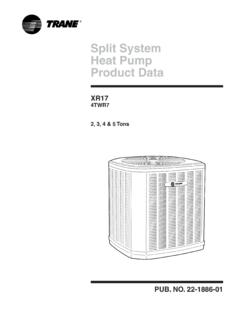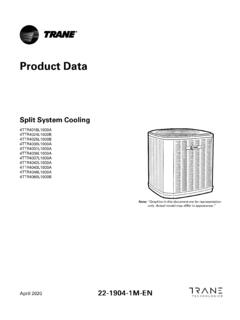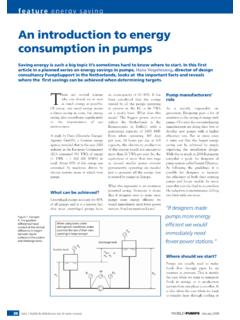Transcription of Dairy Process Engineering - AgriMoon
1 Dairy Process Engineering Upadhyay Sunil M. Patel Dairy Process Engineering Author Upadhyay & Sunil M. Patel Department of Dairy Engineering AAU, Anand Course Outline Lesson Page No Module 1. Evaporation Lesson Principles of Evaporators 5-8 Lesson and Operation of Evaporators 9-13 Lesson Types of Evaporators Used In Dairy Industry 14-22 Lesson of Heat Transfer Area and Water Requirement of Condensers 23-34 Lesson Concepts of Multiple Effect Evaporators 35-42 Lesson and various feeding systems 43-46 Lesson of operation, Thermo processor and MVR system 47-51 Lesson and maintenance of evaporators 52-55 Module 2.
2 Drying Lesson to Principle of Drying 56-59 Lesson Moisture Content, Bound and Unbound Moisture etc. 60-62 Lesson 11. Rate of drying constant and falling rate, Effect of shrinkage 63-70 Lesson of Dryers, Spray Dryers, Drum Dryers and problems on Dryers 71-87 Lesson Heating Systems, Atomization & Feeding System 88-94 Lesson Affecting Bulk Density of Powder, Spray Drying Controls 95-107 Lesson of Solid Gas Sepearation, Cyclone Separators, Bag Filters etc. 108-117 Lesson and Maintenance of Spray and Drum Dryers 118-120 Module 3. Fluidization Lesson of Fluidization, Characteristics of Gas Fluidization Systems, Minimum Porosity, Bed Weight, Pressure Drop in Fluidized Bed.
3 121-124 Lesson of Fluidized Bed in Drying 125-128 Lesson Fluidization, Fluidized bed Dryer 129-133 Module 4. Mechanization in manufacture of indigenous Dairy products Lesson making machines 134-141 Lesson making machines 142-143 Lesson- making equipment 144-151 Lesson- making equipment 152-156 Module 5. Packaging Machines for Milk & Milk Products Lesson Machines for Milk 157-168 Lesson Machines for Milk Products 169-174 Module 6. Membrane Processing Lesson Filtration 175-182 Lesson Osmosis 183-186 Lesson dialysis 187-192 Lesson for Membrane Construction 193-197 Lesson Filtration of Milk 198-201 Lesson of Milk Constituents on Operation of Membrane Process 202-205 Lesson for Electro Dialysis 206-209 Dairy Process Engineering 5 Module 1.
4 Evaporation Lesson-1 Basic Principles of Evaporators Evaporation and vapouration are two processes in which simultaneous heat and mass transfer Process occurs resulting into separation of vapour from a solution. Evaporation and vapourization occur where molecules obtain enough energy to escape as vapour from a solution. The rate of escape of the surface molecules depends primarily upon the temperature of the liquid, the temperature of the surroundings, the pressure above the liquid, surface area and rate of heat propagation to product. VAPOURIZATION AND EVAPORATION Evaporation and vaporization are quite different from each other.
5 The differences are shown in Table : Differences between evaporation and vaporization Vapourization Evaporation (i) Vapourization occurs when entire mass of liquid is raised to the boiling point. (i) It is only a surface phenomenon with only surface molecules escaping at a rate depending upon area of open surface. (ii) It is a much faster Process for the production of vapours. (ii) It is a relatively slow Process and depends mainly on temperature difference and on difference of vapour pressure between air and liquid. (iii) Boiling point is related to the pressure above the liquid surface and the amount of solute. (iii) Evaporation occurs at normal room temperature and application of heat is not necessary under normal evaporation 6 Process .
6 (iv) Vapourization of liquid is visual in the form of vapour bubbles rising and escaping at the surface. (iv) Evaporation is not usually visual and hence not detected easily. (v) Vapourization can be controlled by variation in pressure. (v) Liquid will evaporate until the pressure of its vapour is equal to the equilibrium value. It is the vapour pressure of the liquid for the given temperature of the liquid, for closed system. In case of open system, evaporation will continue till there is no more liquid in the vessel. Evaporation and vapourization occur where molecules obtain enough energy to escape as vapour from a solution.
7 The rate of escape of the surface molecules depends primarily upon the temperature of the liquid, the temperature of the surroundings, the pressure above the liquid, surface area and rate of heat propagation to product. In a closed container with air space above the liquid, evaporation will continue until the air is saturated with water molecules. Removal of water from a liquid product by evaporation is enhanced by adding heat and by removing the saturated air from above the liquid. This is done by removal of vapour from the space above the liquid surface and there by creating vacuum.
8 The boiling point of solution due to dissolved solutes is higher than that of pure water and depends on the molecular weight of the solute. Vacuum is utilized to remove water from liquid/solids at lower temperatures to reduce damage to heat sensitive products which might decompose at higher temperatures. In the Dairy industry evaporation means the concentration of liquid milk products containing dissolved, emulsified or suspended constituents. During this Process water is removed by boiling. This Process is used in the Dairy industry for manufacture of evaporated milk, condensed milk and traditional Indian Dairy products Kheer, Basundi, Khoa etc.
9 In milk condensing plant, milk is condensed by evaporating a part of its water content by using saturated steam. The milk is boiled under vacuum. As the milk boils, water vapour is formed. This vapour is utilized for heating the milk further in the next stage which is at a higher vacuum. Dairy Process Engineering 7 Modern Dairy plants use evaporators to remove part of water from milk by boiling it under low pressure. The Process of evaporation takes place at a maximum temperature of about 70 0C corresponding to an absolute pressure of 230 mm ( inch) of mercury (Hg).
10 Evaporation of milk under low pressure or vacuum is carried out in a specially designed plant. The plant design depends much on the characteristics of liquid milk during boiling at low pressure than any other factor. Some of the important properties of evaporating milk are as under. i Concentration of solids (initial and final) ii Foaming under vacuum iii Heat sensitivity iv Viscosity change The Engineering design of plant requires certain other factors which provide a suitable milk contact surface, cleaning without frequent dismantling, faster heat transfer and economy of steam/power used for operating the plant.
